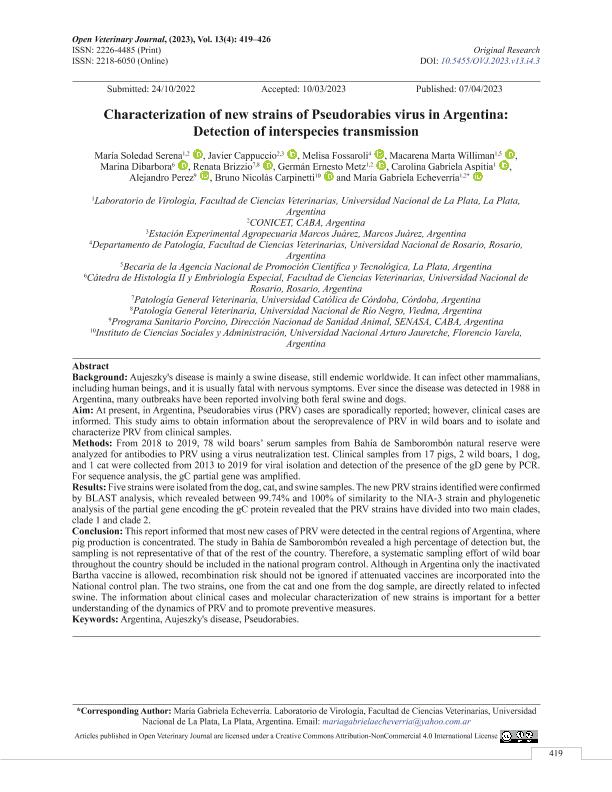Mostrar el registro sencillo del ítem
dc.contributor.author
Serena, Maria Soledad

dc.contributor.author
Cappuccio, Javier Alejandro

dc.contributor.author
Fossaroli, Melisa Gisele

dc.contributor.author
Williman, Macarena Marta

dc.contributor.author
Dibárbora, Marina

dc.contributor.author
Brizzio, Renata

dc.contributor.author
Metz, German Ernesto

dc.contributor.author
Aspitia, Carolina Gabriela

dc.contributor.author
Pérez, Alejandro

dc.contributor.author
Carpinetti, Bruno Nicolás

dc.contributor.author
Echeverria, Maria Gabriela

dc.date.available
2024-01-02T14:40:54Z
dc.date.issued
2023-04
dc.identifier.citation
Serena, Maria Soledad; Cappuccio, Javier Alejandro; Fossaroli, Melisa Gisele; Williman, Macarena Marta; Dibárbora, Marina; et al.; Characterization of new strains of Pseudorabies virus in Argentina: Detection of interspecies transmission; University of Tripoli. Faculty of Veterinary Medicine; Open Veterinary Journal; 13; 4; 4-2023; 419-426
dc.identifier.issn
2226-4485
dc.identifier.uri
http://hdl.handle.net/11336/221995
dc.description.abstract
Background: Aujeszky's disease is mainly a swine disease, still endemic worldwide. It can infect other mammalians, including human beings, and it is usually fatal with nervous symptoms. Ever since the disease was detected in 1988 in Argentina, many outbreaks have been reported involving both feral swine and dogs. Aim: At present, in Argentina, Pseudorabies virus (PRV) cases are sporadically reported; however, clinical cases are informed. This study aims to obtain information about the seroprevalence of PRV in wild boars and to isolate and characterize PRV from clinical samples. Methods: From 2018 to 2019, 78 wild boars’ serum samples from Bahía de Samborombón natural reserve were analyzed for antibodies to PRV using a virus neutralization test. Clinical samples from 17 pigs, 2 wild boars, 1 dog, and 1 cat were collected from 2013 to 2019 for viral isolation and detection of the presence of the gD gene by PCR. For sequence analysis, the gC partial gene was amplified. Results: Five strains were isolated from the dog, cat, and swine samples. The new PRV strains identified were confirmed by BLAST analysis, which revealed between 99.74% and 100% of similarity to the NIA-3 strain and phylogenetic analysis of the partial gene encoding the gC protein revealed that the PRV strains have divided into two main clades, clade 1 and clade 2. Conclusion: This report informed that most new cases of PRV were detected in the central regions of Argentina, where pig production is concentrated. The study in Bahía de Samborombón revealed a high percentage of detection but, the sampling is not representative of that of the rest of the country. Therefore, a systematic sampling effort of wild boar throughout the country should be included in the national program control. Although in Argentina only the inactivated Bartha vaccine is allowed, recombination risk should not be ignored if attenuated vaccines are incorporated into the National control plan. The two strains, one from the cat and one from the dog sample, are directly related to infected swine. The information about clinical cases and molecular characterization of new strains is important for a better understanding of the dynamics of PRV and to promote preventive measures.
dc.format
application/pdf
dc.language.iso
eng
dc.publisher
University of Tripoli. Faculty of Veterinary Medicine
dc.rights
info:eu-repo/semantics/openAccess
dc.rights.uri
https://creativecommons.org/licenses/by-nc/2.5/ar/
dc.subject
ARGENTINA
dc.subject
AUJESZKY'S DISEASE
dc.subject
PSEUDORABIES
dc.subject.classification
Ciencias Veterinarias

dc.subject.classification
Ciencias Veterinarias

dc.subject.classification
CIENCIAS AGRÍCOLAS

dc.title
Characterization of new strains of Pseudorabies virus in Argentina: Detection of interspecies transmission
dc.type
info:eu-repo/semantics/article
dc.type
info:ar-repo/semantics/artículo
dc.type
info:eu-repo/semantics/publishedVersion
dc.date.updated
2023-12-27T17:44:48Z
dc.identifier.eissn
2218-6050
dc.journal.volume
13
dc.journal.number
4
dc.journal.pagination
419-426
dc.journal.pais
Libia

dc.description.fil
Fil: Serena, Maria Soledad. Universidad Nacional de La Plata. Facultad de Ciencias Veterinarias. Departamento de Microbiología. Cátedra de Virología; Argentina. Consejo Nacional de Investigaciones Científicas y Técnicas. Centro Científico Tecnológico Conicet - La Plata; Argentina
dc.description.fil
Fil: Cappuccio, Javier Alejandro. Universidad Nacional de La Plata. Facultad de Ciencias Veterinarias; Argentina. Consejo Nacional de Investigaciones Científicas y Técnicas. Centro Científico Tecnológico Conicet - La Plata; Argentina
dc.description.fil
Fil: Fossaroli, Melisa Gisele. Universidad Nacional de Rosario. Facultad de Ciencias Veterinarias; Argentina
dc.description.fil
Fil: Williman, Macarena Marta. Universidad Nacional de La Plata. Facultad de Ciencias Veterinarias; Argentina
dc.description.fil
Fil: Dibárbora, Marina. Universidad Nacional de Rosario. Facultad de Ciencias Veterinarias; Argentina. Instituto Nacional de Tecnología Agropecuaria. Centro Regional Córdoba. Estación Experimental Agropecuaria Marcos Juárez; Argentina
dc.description.fil
Fil: Brizzio, Renata. Universidad Católica de Córdoba; Argentina
dc.description.fil
Fil: Metz, German Ernesto. Universidad Nacional de La Plata. Facultad de Ciencias Veterinarias. Departamento de Microbiología. Cátedra de Virología; Argentina. Consejo Nacional de Investigaciones Científicas y Técnicas. Centro Científico Tecnológico Conicet - La Plata; Argentina
dc.description.fil
Fil: Aspitia, Carolina Gabriela. Universidad Nacional de La Plata. Facultad de Ciencias Veterinarias; Argentina
dc.description.fil
Fil: Pérez, Alejandro. Ministerio de Agricultura, Ganadería, Pesca y Alimento. Servicio Nacional de Sanidad y Calidad Agroalimentaria; Argentina
dc.description.fil
Fil: Carpinetti, Bruno Nicolás. Universidad Nacional Arturo Jauretche. Instituto Ciencias Sociales y Administracion; Argentina
dc.description.fil
Fil: Echeverria, Maria Gabriela. Consejo Nacional de Investigaciones Científicas y Técnicas. Centro Científico Tecnológico Conicet - La Plata; Argentina. Universidad Nacional de La Plata. Facultad de Ciencias Veterinarias. Departamento de Microbiología. Cátedra de Virología; Argentina
dc.journal.title
Open Veterinary Journal
dc.relation.alternativeid
info:eu-repo/semantics/altIdentifier/url/https://www.ejmanager.com/mnstemps/100/100-1666108780.pdf?t=1683641044
dc.relation.alternativeid
info:eu-repo/semantics/altIdentifier/doi/http://dx.doi.org/10.5455/OVJ.2023.v13.i4.3
Archivos asociados
